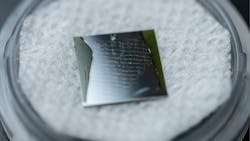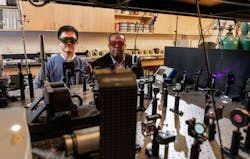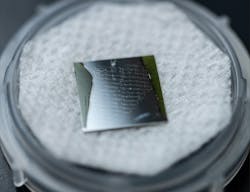Bonding Method Attaches Gallium Nitride to Thermally Conductive Materials
Engineers at the Georgia Institute of Technology have come up with an easier way to attach wide bandgap materials such as gallium nitride (GaN) to thermally conducting materials such as diamond. This would boost the cooling effect on GaN devices and lead to better performance through higher power levels, longer device lifetimes, improved reliability and lower manufacturing costs. The technique could have applications for wireless transmitters, radars, satellite equipment, and other high-power and high-frequency electronic devices.
The technique, called surface-activated bonding, uses an ion source in a high-vacuum to clean the surfaces of the GaN and diamond; it also activates the surfaces by creating dangling bonds. Introducing small amounts of silicon into the ion beams lets the process create strong atomic bonds at room temperature, direct bonding the GaN and single-crystal diamond to make a high-electron-mobility transistors (HEMTs).
The interface layer between GaN and a single-crystal diamond is just four nanometers thick, letting heat dissipate up to two times more efficiently than in current state-of-the-art GaN-on-diamond HEMTs. It does this by eliminating the low-quality diamond left over from nanocrystalline diamond growth. Diamond is currently attached to GaN using crystalline growth techniques that leave a thicker interface layer and low-quality nanocrystalline diamond near the interface. Additionally, the new process can be done at room temperature using surface-activated bonding techniques, reducing the thermal stress applied to the devices.
For high-power electronic applications using materials such as GaN in small devices, heat dissipation can be a limiting factor in the power densities imposed on the devices. Adding a layer of diamond, which conducts heat five times better than copper, engineers have tried to spread and dissipate the thermal energy.
However, when diamond films are grown on GaN, they must be seeded with nanocrystalline particles around 30 nanometers in diameter, and this layer of nanocrystalline diamond has low thermal conductivity. This adds resistance to the flow of heat into the bulk diamond film. In addition, growth takes place at high temperatures, which can create stress-producing cracks in the resulting transistors.
The current growth technique does not reach the high thermal conductivity properties of the microcrystalline diamond layer until a few microns away from the interface. Materials near that interface don’t have good thermal properties. This bonding technique starts with ultra-high thermal conductivity diamond right at the interface.
By creating a thinner interface, the surface-activated bonding technique moves the thermal dissipation closer to the GaN heat source.
This bonding technique brings high thermal conductivity single crystal diamond closer to the hotspots in the GaN devices, which could change the way these devices are cooled. And because bonding takes place near room temperature, it avoids thermal stresses that damage chips.
That reduction in thermal stress can be significant, going from as much as 900 megapascals (MPa) to less than 100 MPa with the room temperature technique.
Besides GaN and diamond, the technique can be used with other semiconductors, such as gallium oxide, and other thermal conductors, such as silicon carbide. The technique has broad applications to bond electronic materials where thin interfacial layers are advantageous.
The researchers plan to study other ion sources and evaluate other materials that could be integrated using the technique.


